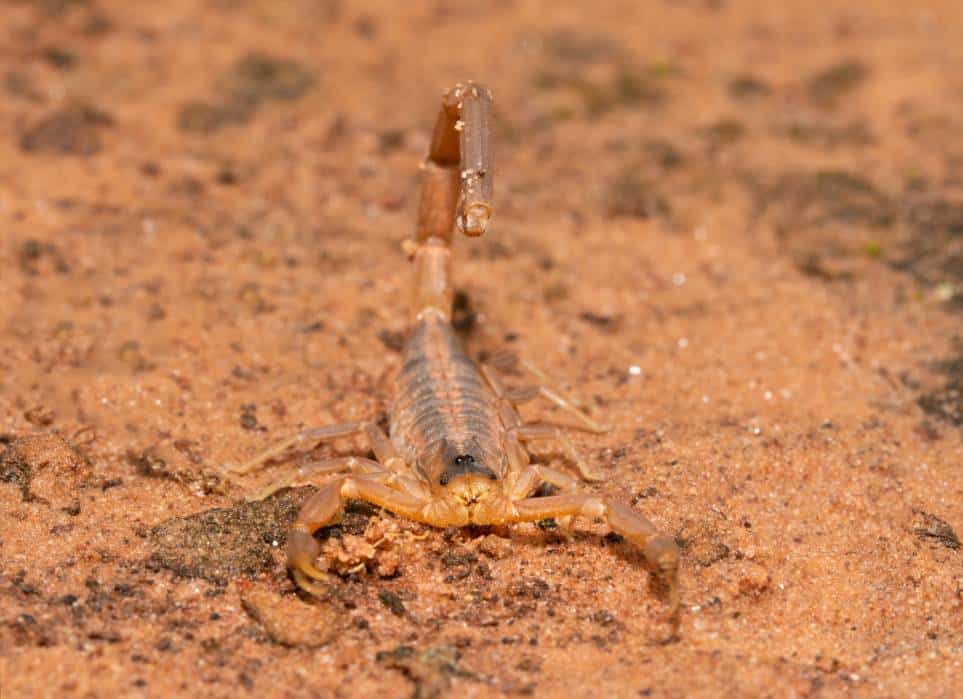There are a wide variety of scorpion species that call Texas their home. Currently, there are 18 recognized species to list, but that number could be larger. Some of the species in Texas are common and well-studied, while others are more recently discovered and very little is known about them.
If you are curious about which species of scorpion inhabit the Lone Star state, keep reading to learn a little more about each one and where they can be found. We have separated those with common names from those that are only identified by their scientific names.

The 18 Scorpions Found in Texas
1. Striped Bark Scorpion
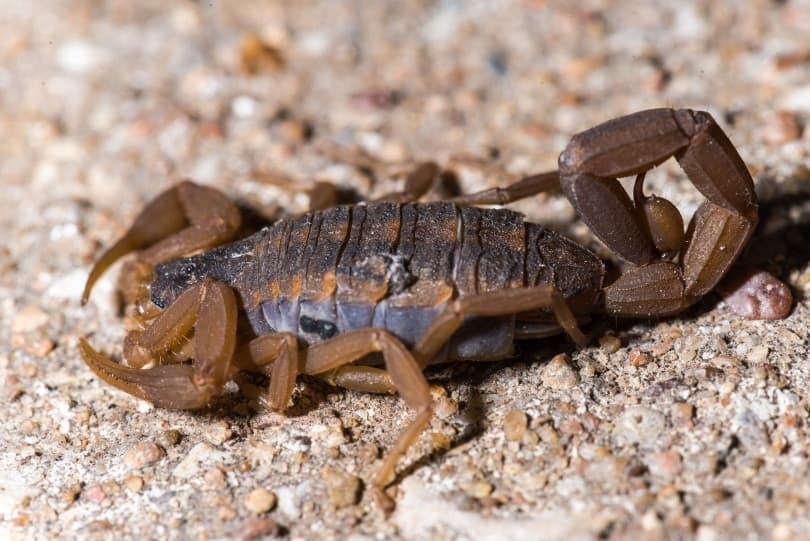
| Species: | Centruroides vittatus |
| Longevity: | 3-5 years |
| Adult Size: | 1-3 inches |
| Primary Diet: | Insects, arthropods, and other arachnids |
The striped bark scorpion is the most widespread species of scorpion in the United States. Though Texas is home to many other species, the striped bark scorpion is also the most prevalent species across the entire state. They are light tan to brown with two dark stripes lengthwise down their backs.
They feed on insects, arthropods, and other arachnids and are highly adaptive species that can tolerate many different climates. They inhabit forests, rocky terrain, and areas with lots of cracks and crevices where they can hide. They are commonly found in all kinds of human dwellings because of the plentiful hiding places and access to easy prey.
This scorpion is venomous, though the venom is not as potent as some other species. A sting from a striped bark scorpion can be quite painful but is typically not medically significant for an average healthy person. Those that experience an allergic reaction to the venom would need to seek medical attention, however.
2. Texas Cave Scorpion
| Species: | Pseudouroctonus reddelli |
| Longevity: | 2-8 years |
| Adult Size: | 1.5-2 inches |
| Primary Diet: | Cave crickets |
The Texas cave scorpion is common in the rocky areas of central Texas where there are plenty of caves and dense limestone habitats. These scorpions are dark in color and have thicker pincers than the striped bark scorpion.
While Texas cave scorpions will feed on any insect, arthropod, or other arachnids it can overpower, their primary diet consists of cave crickets, which are a widespread prey item within their habitat. While rare, these scorpions may occasionally be seen around homes, but they are most often noticed in dark areas underneath wood piles.
Like all scorpions, they are venomous, which is how they subdue their prey. For most people, the sting from a Texas cave scorpion is very similar to the sting of a bee or a fire ant.
3. Trans Pecos Smoothclaw Scorpion
| Species: | Diplocentrus lindo |
| Longevity: | 2-8 years |
| Adult Size: | 1-2 inches |
| Primary Diet: | Insects, arthropods, other arachnids |
The Trans Pecos Smoothclaw scorpion inhabits the Mexican states of Coahuila, Chihuahua, and Nuevo León, and West Texas regions known as the Trans Pecos. They are dark reddish brown with short stocky tails and large pincers.
This species is known for burrowing and will remain in their burrow during the day, only to come out in search of pretty during the night. They will feed on various insects, arachnids, and arthropods and use their large pincers to help them snatch onto their prey. Though their venom is enough to help them subdue their prey, it is less potent than that of other species.
4. Lesser Stripetail Scorpion
| Species: | Chihuahuanus coahuilae |
| Longevity: | 2-8 years |
| Adult Size: | 1-3 inches |
| Primary Diet: | Insects, arthropods, other arachnids |
The Lesser Stripetail scorpion is a light tan with a distinct stripe down its robust tail. This species also has some robust pincers to help them capture and hold onto their prey. These scorpions have a knack for blending into their environments and are common in both South and West Texas and down into Mexico.
This species is rarely found inside homes, but if they are they will hide beneath objects that provide them with cover. While they can be found in a wider range of habitats than some other species, they are most common in desert regions but have also been observed in forested areas.
The lesser stripetail scorpion is a natural burrower that will come out at night to feed on a variety of prey and like other species with larger pincers, their venom is less potent.
5. Intermediate Scorpion
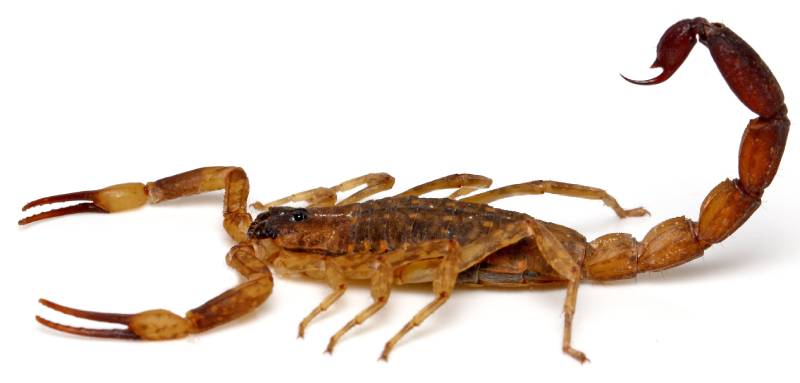
| Species: | Vaejovis intermedius |
| Longevity: | 2-8 years |
| Adult Size: | 1-3 inches |
| Primary Diet: | Insects, arthropods, other arachnids |
The intermediate scorpion is native to Mexico and parts of Texas ranging from Durango throughout the Chihuahuan Desert and into the canyons and mountains of West Texas. This species is a light reddish-brown color with a darker tail.
Unlike a lot of other scorpions, they do not burrow and are strictly rock dwellers that are often spotted near mountainous areas with rocky slopes, cliffs, and roadcuts. They are very quick and agile and do not hesitate to sting when they feel threatened.
They are known for releasing a lot of venoms and having an intense and painful sting, though there is not much known about their venom in terms of scientific research.
6. Wauer’s Dwarf Scorpion
| Species: | Vaejovis waueri |
| Longevity: | 2-8 years |
| Adult Size: | 0.5-1 inch |
| Primary Diet: | Insects, other arachnids |
The Wauer’s dwarf scorpion is a smaller species, hence the name dwarf that is found in the Mexican states of Coahuila, Chihuahua, and West Texas. They are another species known for being rock dwellers that inhabit the rocky slopes of the canyon and mountainous areas of their range.
They are yellowish brown to brown in color with two dark dorsal stripes and a dark tail segment. Their pincers are short and small, and they have very wide abdomens. They feed on a variety of insects and arachnids.
7. Big Bend Scorpion
| Species: | Diplocentrus whitei |
| Longevity: | 2-8 years |
| Adult Size: | 2-3 inches |
| Primary Diet: | Insects, arthropods, other arachnids |
Big Bend scorpion was first discovered in Big Bend National Park in Texas, which is where it got its name. They can also be found throughout northern Coahuila and Chihuahua in Mexico. They are one of the largest species in the Diplocentrus genus and are known rock dwellers that stick to the rocky slopes and hillsides throughout this mountainous region.
They feed on a variety of insects, arthropods, and arachnids. They subdue their prey using their large, robust pincers. Their venom is much less potent than some other scorpion species and is not known for being medically significant to humans.
8. Thick-handed Scorpion
| Species: | Chihuahuanus crassimanus |
| Longevity: | 2-8 years |
| Adult Size: | 1-3 inches |
| Primary Diet: | Insects, arthropods, other arachnids |
Very little is known about the Thick-handed scorpion other than they are nocturnal hunters that remain hidden throughout the day and only come out at night in search of prey. They are sand-colored to blend in with their environment. They are native to the Chihuahuan Desert, though some have been observed in Texas.
9. Russell’s Scorpion
| Species: | Chihuahuanus russelli |
| Longevity: | 2-8 years |
| Adult Size: | 1-2 inches |
| Primary Diet: | Insects, arthropods, other arachnids |
The Russell’s scorpion is another member of the Chihuahuanus genus, which inhabits the Chihuahuan Desert of northern Mexico. This species has also been observed throughout the grasslands and forests of southeastern Arizona and into West Texas.
Their name is in honor of Dr. Fin Russell of Cochise County, Arizona where the first described species were collected. They are a light sandy to yellowish brown with red tips on the end of their pincers. They typically burrow under objects or at the base of plants found throughout their habitat.
10. Eastern Sand Scorpion
| Species: | Paruroctonus utahensis |
| Longevity: | 2-8 years |
| Adult Size: | 1-3 inches |
| Primary Diet: | Insects, other arachnids |
The eastern sand scorpion ranges throughout the Mexican state of Chihuahua and into Arizona, New Mexico, Texas, and as far north as Utah. They are pale yellow and blend in well with their sandy environment and are one of the most common species found around the El Paso area.
Eastern sand scorpions eat a variety of spiders and other large insects. These burrowers prefer loose, sandy habitats and often burrow in dunes at the base of plants. The sting of this species is similar to that of a bee sting, as their venom is mild and only medically significant if there is an allergy to the venom present.
11. Arizona Bark Scorpion
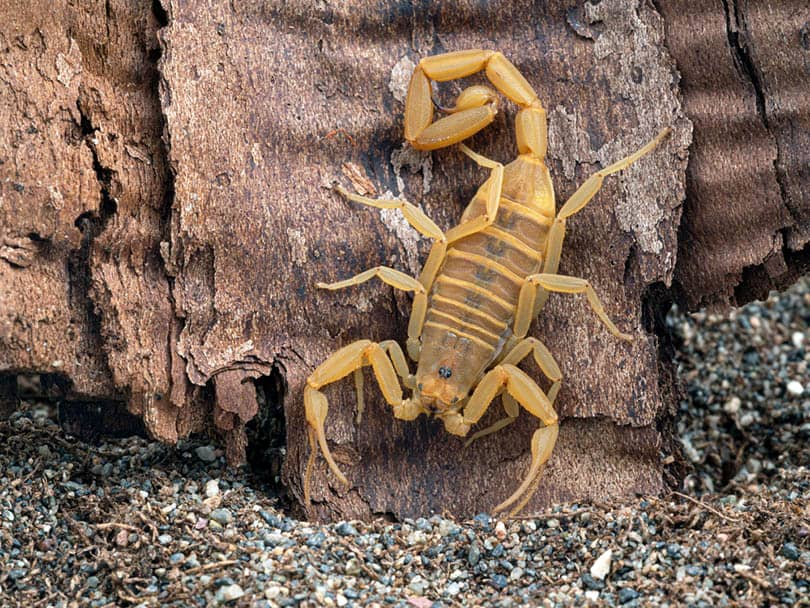
| Species: | Centruroides sculpturatus |
| Longevity: | 2-6 years |
| Adult Size: | 1-3.5 inches |
| Primary Diet: | Insects, arthropods, other arachnids |
The Arizona bark scorpion is very common throughout the state of Arizona and their natural range extends from western New Mexico into southern Utah and Nevada and much of Sonora, Mexico. They have been observed in California along the Colorado River but are uncommon in the area.
This species may not be native to Texas, but they were introduced to the state and are found throughout West Texas. They are light brown in color and are nocturnal hunters that feed on Insects, arthropods, and other arachnids.
These scorpions are often seen inside homes or in and around other human structures. They are excellent climbers that will hide away during the day and then emerge at night to hunt. They are also often observed under rocks, leaves, or wood piles.
The Arizona bark scorpion is the most venomous in the United States. Stings are incredibly painful and accompany symptoms such as nausea, vomiting, numbness, and tingling that can last up to 72 hours. Their venom is potentially lethal, especially to those with weaker immune systems like children or the elderly.
12. Giant Hairy Scorpion
| Species: | Hadrurus arizonensis |
| Longevity: | 2-8 years |
| Adult Size: | 4-7 inches |
| Primary Diet: | Insects, arthropods, other arachnids, lizards, small mammals |
The giant hairy scorpion is the largest species of scorpion in North America, reaching 4 to 7 inches in length compared to other species that average 1 to 3 inches. They are distributed throughout Mexico, Arizona, parts of southern California, Nevada, Utah, and areas of southwest Texas.
This species will feed on insects, arthropods, and arachnids and is even large enough to take down lizards and small mammals. They like to burrow deep and are typically found under rocks and logs. Their sting may be painful, but the venom is not medically significant to your typical healthy adult human, though there are concerns for those that suffer from an allergic reaction to the venom.
13. Chihuahuan Slendertailed Scorpion
| Species: | Paruroctonus gracilior |
| Longevity: | 3-5 years |
| Adult Size: | 1-2 inches |
| Primary Diet: | Insects, other arachnids |
The Chihuahuan slendertailed scorpion is a yellow to greenish brown in coloration and is native to Texas, Arizona, New Mexico, and the Mexican states of Chihuahua, Coahuila, and Aguascalientes. These burrowers prefer sandy habitats and often dig at the base of vegetation, though they are sometimes found under rocks.
They have very robust pincers and elongated, slender tails. Like most species, they feed on a variety of insects and other arachnids, mainly spiders. Their venom is considered mild and is not typically medically significant to your average person unless there is an allergic response to the envenomation.
Species of Scorpion Lacking a Common Name
14. Vaejovis Chisos
| Species: | Vaejovis chisos |
| Longevity: | Unknown |
| Adult Size: | 1-3 inches |
| Primary Diet: | Insects, arthropods, other arachnids |
Vaejovis Chisos are a species of light brown scorpion found throughout the forests, canyons, and caves of the Trans Pecos region of Texas and into the state of Coahuila, Mexico. Not a lot is known about this species other than they have a primary diet of insects, arthropods, and other arachnids, like most scorpions. The state of Texas considers the Vaejovis Chisos a “Species of Greatest Conservation Need.”
15. Paruroctonus Boquillas
| Species: | Paruroctonus Boquillas |
| Longevity: | Unknown |
| Adult Size: | 2-2.5 inches |
| Primary Diet: | Insects, other arachnids |
Very little is known about the rare and elusive Paruroctonus Boquillas. This species has only been observed around the sand dunes along the Rio Grande in Boquillas Canyon, Big Bend National Park in Brewster County, Texas.
Their bodies are very pale with pale yellowish tan tails and appendages. Like most other species of scorpion, they likely prey on a variety of insects and spiders.
16. Chihuahuanus Globosus
| Species: | Chihuahuanus Globosus |
| Longevity: | Unknown |
| Adult Size: | 0.75-1.5 inches |
| Primary Diet: | Insects, other arachnids |
Chihuahuanus Globosus is a small species of scorpion that only reaches about 1.5 inches in length. They are nocturnal hunters that are very seldom observed but have been seen under rock and wood piles in southwestern Texas. Thus far, there is very little known about this rare species in the Chihuahuanus genus.
17. Pseudouroctonus Apacheanus

| Species: | Pseudouroctonus Apacheanus |
| Longevity: | 3-5 years |
| Adult Size: | 1-3 inches |
| Primary Diet: | Insects, arthropods, other arachnids |
Pseudouroctonus apacheanus have been observed throughout the mountains and canyons of West Texas ranging from Del Rio to Big Bend and Carlsbad Caverns National Parks. They have also been identified in southwestern New Mexico, southern Arizona, and down into northern Mexico.
These species are a dark to medium reddish-brown color with lighter, thick abdomens. Their coloration becomes noticeably darker on their tails and robust pincers, especially on certain specimens.
18. Pseudouroctonus Brysoni
| Species: | Pseudouroctonus Brysoni |
| Longevity: | Unknown |
| Adult Size: | 1-3 inches |
| Primary Diet: | Insects, other arachnids |
Pseudouroctonus Brysoni is a newly discovered species within the last 5 years. It is closely related to Pseudouroctonus apacheanus and two other species that were recently described in southern Arizona. This species has been observed in the canyons in West Texas among the rock cuts.
They are dark red in coloration with much lighter legs and more slender bodies compared to Pseudouroctonus apacheanus. There have been very few observations of this species thus far and there is currently very little information about them.

Scorpions in the United States
Scorpions are arachnids that fall under the order of Scorpiones. There are over 1,500 species that have been identified and scientists estimate there could be at least 1,000 more that have yet to be discovered.
These incredible animals date back hundreds of millions of years and can be found on every continent. Around 90 species of scorpion have been identified in the United States with most occurring in the southwestern region of the country.
Appearance
Scorpions are positioned low to the ground and have eight legs, four on each side of their body. They have a pair of grasping pincers and a segmented tail that curves forward with a stinger on the end. Scorpions will range in size and shape depending on the species. On average, they tend to range from 1 to 3 inches in length but the largest species in the United States can reach up to 7 inches.
Pincers range from slender to thick and robust. This is typically associated with venom potency, as many species with more robust pincers have less potent venom.

Life Cycle
Scorpions are very long-lived compared to many other arachnids. While their average lifespan is anywhere from 3 to 8 years in the wild, they have been known to live 15 years or more. Females give live birth to 20 to 50 nymphs, which they will carry on their backs.
They are relatively slow growers, with species being a determining factor in certain growth rates and other lifestyle habits. It typically takes 1 to 3 years for a scorpion to reach maturity, averaging around 5 or 6 molts during that time frame.
Scorpion species that live in tropical regions typically mate during the rainy season, while those in temperate regions mate during the spring or summer, depending on the species. In most areas of the United States, especially those that experience colder winters, scorpions will be seen from March through October.
Habitat
Considering that scorpions inhabit every continent except for Antarctica, it may come as no surprise that they have variable habitats including deserts, canyons, forests, grasslands, and savannahs.
Habitat depends on the species, with most in the United States gravitating toward the southwestern desert regions in semi-arid to arid climates. A lot of scorpions are burrowers that hide beneath the surface during the day.
Those that are not burrowers will hide under various surfaces like wood, leaves, rocks, and other debris. They also commonly hide in cracks and crevices like rock cuts and even within human structures.
- Alabama
- Arizona
- Arkansas
- California
- Colorado
- Florida
- Georgia
- Hawaii
- Idaho
- Illinois
- Kansas
- Kentucky
- Louisiana
- Mississippi
- Missouri
- Montana
- Nebraska
- Nevada
- New Mexico
- North Carolina
- Oklahoma
- Oregon
- South Carolina
- Tennessee
- Texas
- Utah
- Virginia
- Washington
- West Virginia
- Wyoming
Eating Habits
Scorpions are solitary, nocturnal predators that prey on a wide variety of insects, arthropods, spiders, and other arachnids. Some of the larger scorpions can even take down larger prey like lizards and small mammals. They spend their day hiding and emerge at night to hunt. They subdue their prey by grabbing them with their pincers and using their stinger to inject venom.
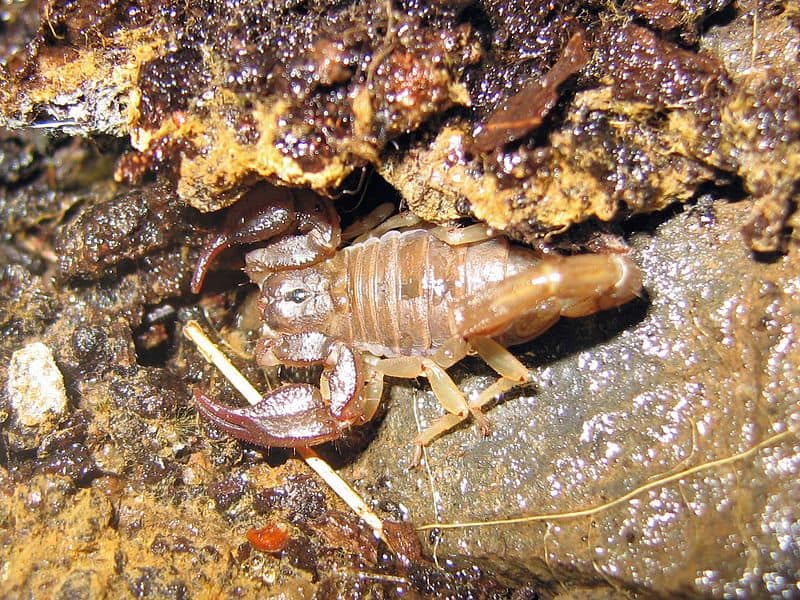
Are All Scorpions Venomous?
All scorpions have venom, though the venom can vary greatly in potency depending on the species. Their venom is how they naturally immobilize their prey and in cases where they feel their life is being threatened, it can also be used as a defensive mechanism.
Out of more than 1,500 recognized species in the world, only between 25 and 30 of them have venom medically significant enough to be life-threatening, with the Arizona Bark Scorpion being the most medically significant in the United States. For the most part, scorpion stings are very similar to bee stings and can usually be treated at home.
There are cases in which a person can have an allergic reaction to even mild venom and would require immediate medical care. As of 2021, there were 4 reported deaths within an 11-year timespan from scorpion envenomation within the United States. If there are any concerns about a scorpion sting, it is recommended to reach out to your healthcare provider.

Final Thoughts
There are currently 18 species of scorpion that have been identified within the state of Texas, though there may be as many as 20. Several species in Texas do not yet have common names, as they are recently discovered and not much is yet known about them. Scorpions are very interesting predatory arachnids that are solitary and elusive. They prefer to have nothing to do with humans, though they may be found in and around homes at times.
Featured Image Credit: Sari ONeal, Shutterstock
